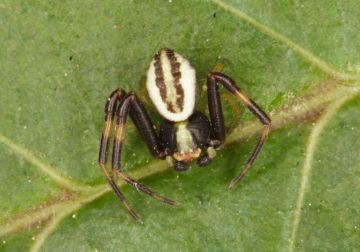Summary for Misumena vatia (Araneae)
previous species | next species
National Distribution
Terms of Use. Double-click on map to go to region

Explore Regional Distribution
View notes or log on and add a note on this species
About this species
Recorded altitude range0m to 350m
Species text
DistributionThe species is widespread in the southern half of England and Wales. It is widespread in western and central Europe, but commoner towards the south of the region (Roberts 1995).
Habitat and ecology
This species seems to be most commonly found in the boundary region between grass and scrub, such as the edges of woodland rides but it also occurs in more open locations. It may be found in the vegetation, or sitting on a flower head waiting for prey. In these situations its cryptic colouring may make it difficult to see until it moves, especially as the colouring may vary through white, yellow and greenish to match the flower. Only mature females can undergo background-matching colour changes. Some females have red anterior, dorso-lateral lines or spots which appear to be genetically determined and are unaffected by the background colour. Mature males are smaller and predominantly brown. The sexual dimorphism for colour is probably a result of males and females occupying different niches (Oxford and Gillespie 1998). Adults of both sexes have been recorded between May and August, but mainly in May and June with females occasionally persisting into the autumn or perhaps even through the winter with one female recorded in leaf litter in March.
Status
The spider is fairly common in the south.
Original author of profile: W.J. Partridge
Text based on Harvey, P.R., Nellist, D.R. & Telfer, M.G. (eds) 2002. Provisional atlas of British spiders (Arachnida, Araneae), Volumes 1 & 2. Huntingdon: Biological Records Centre. References
Adult Season
Habitats
background methodology
Recorded management for locations with Misumena vatia
Recorded substrate and hydrology for locations with Misumena vatia
Images
please log on and upload a new image for this speciesSee also A-Z Species Index - A-Z Picture Index - previous species | next species









































